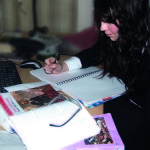Suffragettes
How Britain’s women fought & died for the right to vote
Stroud, Amberley, 2014, ISBN:978-1-4456-3390-9
Reviewed by Rachel Gillard, University of Liverpool
Frank Meeres is a senior archivist and author living and working in Norwich where he has been involved with important local historical activities. Norfolk played a significant role in the campaign for women to gain the right to vote. This inspired the author to tell the story of the suffrage movement on a national level, giving an historical account of how women fought to gain voting equality with men. It is an informative and captivating overview of this period of history. Meeres draws upon numerous historical accounts and personal testimonies to portray the events that led to victory and the struggles that occurred within the Suffrage movement itself.
Meeres, in his introduction, includes a quote from 1908 by Charlotte Carmichael Stopes in which she observed that being a woman born in Britain, ‘is according to the definition doomed to be a slave. Slavery consists in having to obey laws in the making of which one has no voice’ (p.10-11). It is with this supposition that Meeres charts chronologically the journey from slavery to freedom for the women of Britain. He summarises the debates, petitions and traditional campaigning methods that were employed in the nineteenth century to win the right for women to vote. However by the beginning of the twenntieth century these peaceful, law-abiding strategies had failed to achieve their purpose, giving rise to the adoption of more militant tactics.
The book includes portrayals of the role of two of the most significant societies in the suffrage campaign, the National Union of Women’s Suffrage Society (NUWSS) formed in 1897 by Milicent Fawcett and the Women’s Social and Political Society (WSPU) formed in 1903 by Emmeline Pankhurst, as a rival group. The NUWSS continued to campaign by lobbying parliament and organising large marches and rallies, whilst the WSPU considered these methods ‘too feeble and too middle-class’ (p.28). After being arrested and then imprisoned in Manchester, for defying a banning order, Pankhurst saw the power of publicity by such actions. Initially Fawcett was supportive of the more militant tactics employed by the WSPU acknowledging that they had achieved in a few months what the NUWSS had endeavoured to do in years. However as the campaigns escalated in their militancy, including window smashing, arson and the destruction of property, this view changed and in 1908 the NUWSS publically disavowed the methods of the militants.
Both continued in their endeavours and Meeres takes care to chart both of their journeys. He includes many anecdotes of the WSPU’s campaigns, but also pays attention to the grassroots methods of the NUWSS and gives a good account of their campaign which, although less prominent, was arguably equally as effective. The author makes it clear that the militant activities which received the headlines were carried out by the minority and that it was the non-militant campaigners who were by far the majority.
The book briefly concludes by documenting how the vote was eventually won. Meeres takes care to stress the effectiveness of the suffrage campaign prior to the war but argues that World War 1 made it unthinkable that women could not have the vote, when they had contributed so much to the war effort. He goes on to reason that they didn’t achieve full emancipation in 1918 due to the fact that there were more women in the country than men. If the vote had been given to all women they would then have had the majority of the vote, unthinkable to an all-male government.
Whilst this book is not a detailed analysis and debate of the issues involved in the fight for female suffrage, it is a comprehensive introduction to the events that took place during this crucial period of struggle for women to attain ‘freedom and equality’ (p.11). The extensive use of anecdotes, through which the story of the women’s suffrage movement is told, makes the book poignant and very accessible. It could be argued that the use of the title ‘Suffragettes’ is somewhat misleading. From my understanding this term referred to the militant campaigners whilst the peaceful campaigners were known as suffragists. Meeres’ book is a biography of the suffrage movement as a whole; therefore the use of suffragette could be viewed as too narrow. The author clearly aims to challenge the reader, particularly women, not just to read the book as an historical account but to be impacted by the passion and dedication that the suffragettes and suffragists demonstrated throughout their long and vigorous campaign.










Leave a Reply